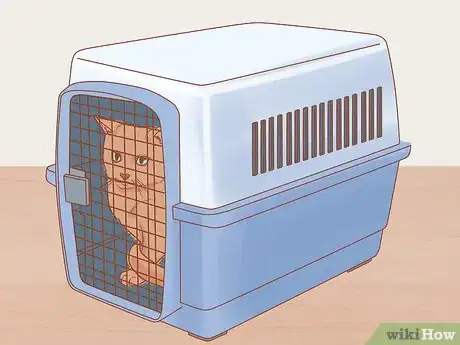This article was co-authored by Tabitha Kucera. Tabitha Kucera is a Registered Veterinary Technician & Cat and Dog Behavior Consultant and the Owner of Chirrups and Chatter Cat and Dog Behavior Consulting and Training in Cleveland, Ohio. Tabitha has over ten years of experience working at animal veterinary hospitals, farm sanctuaries, and cat and dog rescue centers. Tabitha has helped to develop training and behavior programs for various veterinary hospitals and shelters and works as a consultant for many shelters and private veterinary practices. Her teaching credentials include lecturing at regional and national levels and at multiple veterinary technology programs. She is a Fear Free certified speaker, a Fear Free Practice Certification Consultant, a behavior consultant for Cat Pawsitive Pro, and host of the podcast, Tails from a Vet Tech. She currently serves on the board of the Pet Professional Guild’s Cat Committee and is the President of the Society of Veterinary Behavior Technicians. She is an Elite Fear Free and Low-Stress Handling Certified Registered Veterinary Technician, a certified cat behavior consultant, a Karen Pryor Academy certified training partner, and has a Veterinary Technician Specialist (VTS) designation in behavior.
This article has been viewed 18,967 times.
Adopting a cat that has already been in another home or shelter is a great act of kindness that the cat will surely learn to appreciate, as long as you take the right steps to introduce it to your home. Create a safe room in your home before you even bring the cat home, allow the cat to get used to the room at its own pace, then gradually let it explore the rest of your home. Be patient and understand that the experience is probably very stressful for the cat.
Steps
Creating a Safe Room
-
1Pick a room in your house that has a secure door. Decide on a room in your home that will be a safe space for your new cat while it adjusts to your home. You need to be able to close the door and let the cat stay inside undisturbed.[1]
- This safe space will allow your new cat to adjust to the sounds and smells of your home.
- The size of the room is not important.
-
2Cat-proof the room and add lots of safe hiding places. Hiding is a natural coping mechanism for cats, so it's crucial to provide safe hiding places such as a cardboard box or their carrier. Make sure to cover up any vents, clear off any shelves, and block off any areas where they could hide and injure themselves.Advertisement
-
3Make a small hiding spot with a cardboard box or a sheet draped over a chair. The new cat will most likely want to hide a lot when it first arrives in your home. This will allow the cat to feel comfortable, but still let you interact with it in the safe room.[2]
- You could also use a shirt or piece of clothing of yours to create a cave for the cat, so that it gets accustomed to your scent.
- If you can, give the cat something like a blanket from its old home in the hiding spot to help it feel more comfortable.
-
4Put a litter box, cat food, and water in the safe room. Make sure the safe room contains all of the cat’s necessities so that it doesn’t have to leave the room to eat, drink, or go to the bathroom. Place the litter box on the opposite side of the room from the food and water.[3]
- Talk to the previous owner if possible, or the staff at the shelter if you adopted the cat, to find out what the cat was eating before and what it likes. Try to buy the same kind of food and any kinds of treats or special foods that it likes.
- Don’t be alarmed if the cat doesn’t eat for the first 1-2 days. This is normal as the cat gets comfortable in its new environment. If it goes longer than 2 days without eating, try giving it some tasty treats like canned salmon or tuna.
-
5Provide a scratching post in the safe room. Cats need to scratch things to wear down their claws. Put a scratching post in a corner of the safe room so your cat can do this.[4]
- This will also discourage the cat from destroying any carpets or furniture.
- Many cats like to scratch right after they wake up. Try placing a scratching post right next to the area where your cat usually sleeps.
-
6Give your new cat some toys for entertainment in the safe room. Purchase some cat toys like fake mice or balls with bells in them. Put a few in the safe room so that your new cat does not get bored and to show it that you love it.[5]
- Make sure that the toys (and everything else) you give your new cat are brand new and have not been used by any other cats.
Bringing the Cat Home
-
1Bring the cat to your home in a cat carrier. The cat will feel safer inside of an enclosed carrier. Put the cat in the carrier, securely close the door, and bring it home right away.[6]
- You can use treats to entice the cat into the carrier if it is shy or hesitant.
-
2Take the cat into its safe room and let it out of the carrier. Go into the safe room you created and close the door behind you. Set the carrier gently on the floor and open the door to let the cat come out and start to explore the room.[7]
- Don’t force the cat out. Just let it come out on its own time and at its own pace.
- Ask the previous owner or shelter staff if the cat is particularly shy, or if they have any advice about its personality.
-
3Sit on the floor and let the cat come to you if it wants to. Calmly sit down on the floor of the safe room as the cat explores its new territory. Don’t try to make it come to you or make any moves towards it, just be patient and let it do whatever it feels comfortable with.
- If the cat does not come out of the carrier, or if it runs to the hiding spot you made for it right away, then leave the room and let it be alone for a while to get comfortable.
Getting the Cat Used to You and Your Home
-
1Visit the cat frequently for short periods of time for the first 2-3 weeks. Evaluate the cat’s behavior towards you to determine how to act. Simply sit in the room quietly if it is very shy, or play with one of its toys if it approaches you.[8]
- If the cat seems very stressed or acts aggressively towards you, then talk softly to it and then leave the room to give it space and alone time.
-
2Let the cat explore the rest of the house when it is comfortable with you. Close as many doors to other rooms as you can, and leave the cat’s safe room door open. Let it come out and begin to explore the house at its own pace.
- Make sure all doors and windows to the outside are closed.
- Letting the cat get used to your home in stages will make the process less stressful. If there are too many new spaces to explore, it can overwhelm your cat.
- Don’t let the new cat into areas like basements that might have a lot of hiding places where you cannot get to the cat.
-
3Read about how to introduce cats to other pets if you have a cat or a dog. The cat might only take a few days or weeks to get used to your home if it is the only pet. Make sure you know how to introduce it to your other cats or dogs if they are present in your home.[9]
- It’s a good idea to wait at least 7-10 days before you try to introduce your new cat to other pets.
- Be sure to find out from the previous owner or shelter staff if the cat has any experience with other cats or dogs before you introduce it to yours.
Expert Q&A
-
QuestionCan cats bond with more than one person?
 Tabitha KuceraTabitha Kucera is a Registered Veterinary Technician & Cat and Dog Behavior Consultant and the Owner of Chirrups and Chatter Cat and Dog Behavior Consulting and Training in Cleveland, Ohio. Tabitha has over ten years of experience working at animal veterinary hospitals, farm sanctuaries, and cat and dog rescue centers. Tabitha has helped to develop training and behavior programs for various veterinary hospitals and shelters and works as a consultant for many shelters and private veterinary practices. Her teaching credentials include lecturing at regional and national levels and at multiple veterinary technology programs. She is a Fear Free certified speaker, a Fear Free Practice Certification Consultant, a behavior consultant for Cat Pawsitive Pro, and host of the podcast, Tails from a Vet Tech. She currently serves on the board of the Pet Professional Guild’s Cat Committee and is the President of the Society of Veterinary Behavior Technicians. She is an Elite Fear Free and Low-Stress Handling Certified Registered Veterinary Technician, a certified cat behavior consultant, a Karen Pryor Academy certified training partner, and has a Veterinary Technician Specialist (VTS) designation in behavior.
Tabitha KuceraTabitha Kucera is a Registered Veterinary Technician & Cat and Dog Behavior Consultant and the Owner of Chirrups and Chatter Cat and Dog Behavior Consulting and Training in Cleveland, Ohio. Tabitha has over ten years of experience working at animal veterinary hospitals, farm sanctuaries, and cat and dog rescue centers. Tabitha has helped to develop training and behavior programs for various veterinary hospitals and shelters and works as a consultant for many shelters and private veterinary practices. Her teaching credentials include lecturing at regional and national levels and at multiple veterinary technology programs. She is a Fear Free certified speaker, a Fear Free Practice Certification Consultant, a behavior consultant for Cat Pawsitive Pro, and host of the podcast, Tails from a Vet Tech. She currently serves on the board of the Pet Professional Guild’s Cat Committee and is the President of the Society of Veterinary Behavior Technicians. She is an Elite Fear Free and Low-Stress Handling Certified Registered Veterinary Technician, a certified cat behavior consultant, a Karen Pryor Academy certified training partner, and has a Veterinary Technician Specialist (VTS) designation in behavior.
Registered Veterinary Technician & Cat and Dog Behavior Consultant Oh, for sure. Cats bond with you as their caregiver, but they can bond with other people as well. Even as a behavior consultant and vet tech, I've created bonding relationships with my clients’ cats. Cats are similar to dogs; they love their people, they love to be around their people and they definitely bond to you.
Oh, for sure. Cats bond with you as their caregiver, but they can bond with other people as well. Even as a behavior consultant and vet tech, I've created bonding relationships with my clients’ cats. Cats are similar to dogs; they love their people, they love to be around their people and they definitely bond to you. -
QuestionWhat if the cat becomes homesick?
 Tabitha KuceraTabitha Kucera is a Registered Veterinary Technician & Cat and Dog Behavior Consultant and the Owner of Chirrups and Chatter Cat and Dog Behavior Consulting and Training in Cleveland, Ohio. Tabitha has over ten years of experience working at animal veterinary hospitals, farm sanctuaries, and cat and dog rescue centers. Tabitha has helped to develop training and behavior programs for various veterinary hospitals and shelters and works as a consultant for many shelters and private veterinary practices. Her teaching credentials include lecturing at regional and national levels and at multiple veterinary technology programs. She is a Fear Free certified speaker, a Fear Free Practice Certification Consultant, a behavior consultant for Cat Pawsitive Pro, and host of the podcast, Tails from a Vet Tech. She currently serves on the board of the Pet Professional Guild’s Cat Committee and is the President of the Society of Veterinary Behavior Technicians. She is an Elite Fear Free and Low-Stress Handling Certified Registered Veterinary Technician, a certified cat behavior consultant, a Karen Pryor Academy certified training partner, and has a Veterinary Technician Specialist (VTS) designation in behavior.
Tabitha KuceraTabitha Kucera is a Registered Veterinary Technician & Cat and Dog Behavior Consultant and the Owner of Chirrups and Chatter Cat and Dog Behavior Consulting and Training in Cleveland, Ohio. Tabitha has over ten years of experience working at animal veterinary hospitals, farm sanctuaries, and cat and dog rescue centers. Tabitha has helped to develop training and behavior programs for various veterinary hospitals and shelters and works as a consultant for many shelters and private veterinary practices. Her teaching credentials include lecturing at regional and national levels and at multiple veterinary technology programs. She is a Fear Free certified speaker, a Fear Free Practice Certification Consultant, a behavior consultant for Cat Pawsitive Pro, and host of the podcast, Tails from a Vet Tech. She currently serves on the board of the Pet Professional Guild’s Cat Committee and is the President of the Society of Veterinary Behavior Technicians. She is an Elite Fear Free and Low-Stress Handling Certified Registered Veterinary Technician, a certified cat behavior consultant, a Karen Pryor Academy certified training partner, and has a Veterinary Technician Specialist (VTS) designation in behavior.
Registered Veterinary Technician & Cat and Dog Behavior Consultant The best thing to do is to give them space if they're looking anxious or stressed. If your new cat is fearful of humans, creating a safe place away from humans is really helpful. assess their body language and respect it. Be patient. And if you're in the home with the cat, that cat should have hiding places that are appropriate like various boxes, cat carriers, vertical spaces so they have safe places to get away from the scary human. Remember that it's not personal.
The best thing to do is to give them space if they're looking anxious or stressed. If your new cat is fearful of humans, creating a safe place away from humans is really helpful. assess their body language and respect it. Be patient. And if you're in the home with the cat, that cat should have hiding places that are appropriate like various boxes, cat carriers, vertical spaces so they have safe places to get away from the scary human. Remember that it's not personal.
Expert Interview

Thanks for reading our article! If you'd like to learn more about treating cats, check out our in-depth interview with Tabitha Kucera.
References
- ↑ https://www.meowfoundation.com/resources/new-cat/
- ↑ https://www.meowfoundation.com/resources/new-cat/
- ↑ https://www.meowfoundation.com/resources/new-cat/
- ↑ https://www.petfinder.com/cats/bringing-a-cat-home/tips-for-first-30-days-cat/
- ↑ https://www.petfinder.com/cats/bringing-a-cat-home/tips-for-first-30-days-cat/
- ↑ https://www.petfinder.com/cats/bringing-a-cat-home/tips-for-first-30-days-cat/
- ↑ https://www.petfinder.com/cats/bringing-a-cat-home/tips-for-first-30-days-cat/
- ↑ https://www.meowfoundation.com/resources/new-cat/
- ↑ http://www.georgiaspca.org/qa-sfspca-intro-cat-to-new-home
































































